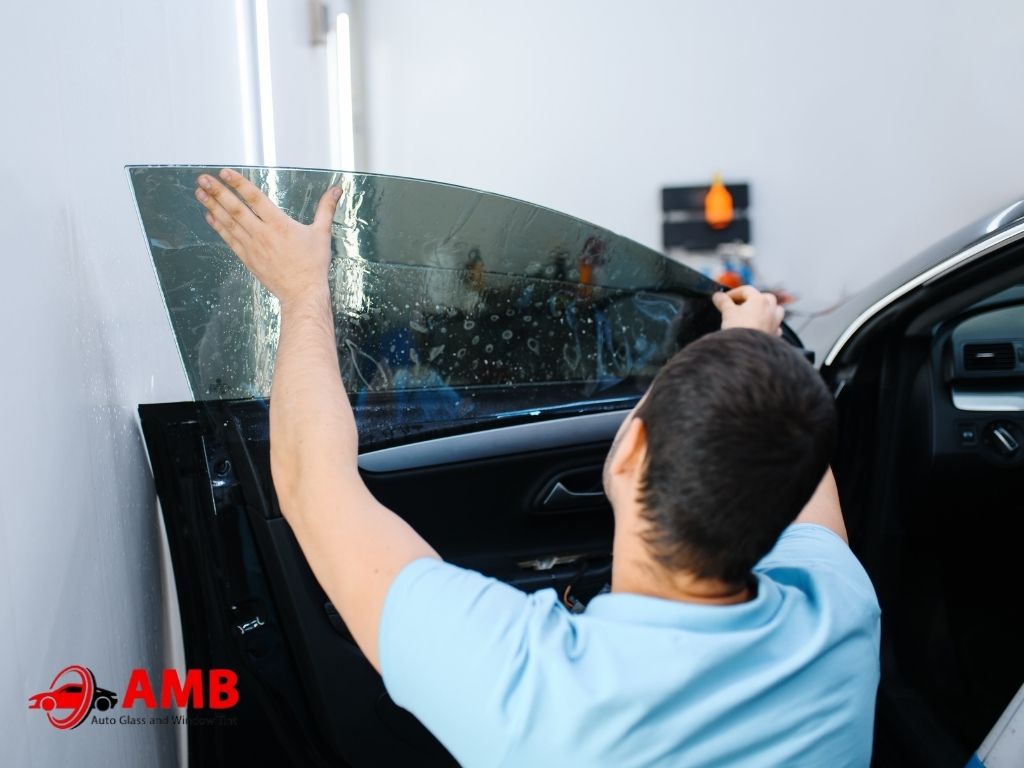The significance of heat rejection in window tinting cannot be overstated, as it directly translates to substantial energy savings, heightened comfort for occupants, and formidable protection against harmful ultraviolet rays.
Understanding how to maximize the benefits of the best window tint for heat rejection can transform an ordinary car into a paragon of efficiency and comfort.
Tip #1: Opt for High-Quality Window Tint
Investing in the best car window tint for heat rejection, specifically designed for this purpose, is important so you should prioritize those with a high Solar Heat Gain Coefficient (SHGC) rating. This metric indicates how effectively the tint blocks solar heat.
Higher SHGC ratings signify greater heat rejection, ensuring a cooler interior even on the hottest days, thanks to such a tint’s ability to block infrared rays, a feature especially beneficial in metalized window tint containing tiny metallic particles.
While the initial investment may be higher, the long-term benefits in comfort and protection make it worthwhile.
Tip #2: Choose the Right Shade
The shade of window tint you select significantly influences its heat rejection capabilities.
Dark tint has a propensity to absorb more heat, thus providing better heat rejection but potentially sacrificing visibility. Conversely, lighter tints offer improved visibility but may provide less effective heat rejection.
It’s crucial to strike a balance between these factors based on your personal preferences and the climate of your region. Consider factors such as sunlight intensity and your driving habits when deciding on the optimal tint shade for your car.
Tip #3: Ensure Proper Installation
Even the highest quality window tint for heat rejection will fail to perform optimally if not installed correctly. Proper installation maximizes the tint’s effectiveness and longevity.
It’s imperative to enlist the services of a professional with expertise in installing window tint to avoid common issues such as bubbles, creases, and gaps.
These imperfections not only compromise the aesthetic appeal but also hinder the tint’s ability to reject heat, defeating its purpose. Prioritize skilled installers who can guarantee a seamless and precise application for optimal results.
Tip #4: Keep Your Windows Clean
Regular maintenance of your car window tints is essential to ensure continued heat reduction and overall visibility, thereby keeping your car’s interior cool.
Dirt, dust, and debris accumulation on windows can impede the tint’s ability to block solar heat, resulting in compromised performance and increased discomfort.
Regularly clean your tinted windows using a mild detergent and soft cloth to remove any contaminants, ensuring the window film continues blocking UV rays effectively. Pay close attention to the edges and corners where dirt tends to accumulate, ensuring thorough cleanliness and optimal heat rejection.
By maintaining clean windows, you not only enhance heat rejection but also improve visibility, promoting safer driving conditions.
Tip #5: Use Sunshades or Window Visors
Complementing your window tint with additional accessories like sunshades or window visors can further enhance heat rejection and comfort levels inside your car. These accessories minimize heat buildup and reduce the strain on your vehicle’s cooling system.
When parked, deploying sunshades or visors prevents the sun’s rays from penetrating the windows, preserving a cooler interior temperature.
Incorporating these accessories into your car maintenance routine can significantly improve heat rejection efficiency, ensuring a more pleasant driving experience in all weather conditions.
Tip #6: Park in the Shade
Maximizing heat rejection in your car starts before you even hit the road—by parking smartly. Whenever feasible, opt for shaded parking spots to minimize sun exposure and subsequent heat buildup.
Shaded areas under trees or in covered parking lots offer natural protection against solar radiation, significantly reducing the temperature inside your vehicle.
Additionally, utilizing car shades or sunshades when parking outdoors provides an extra layer of defense against intense sunlight, ensuring a cooler interior upon your return.
Tip #7: Allow Proper Cure Time
After installing window tint, patience is key to ensuring optimal performance. Allow sufficient time for the tint to cure properly before rolling down windows or cleaning them.
This curing process is crucial for the tint to adhere securely to the glass surface, maximizing heat rejection effectiveness. Rushing this step can compromise the tint’s integrity, leading to issues such as peeling or bubbling.
By following manufacturer recommendations and giving the tint ample time to cure, you’ll enhance its durability and longevity, ultimately enjoying prolonged comfort and protection.
Tip #8: Consider Ceramic Window Tint
When seeking superior heat rejection capabilities, ceramic window tints emerge as a top contender. While it may entail a higher upfront cost compared to traditional tints, its exceptional performance justifies the investment, particularly in hotter climates.
Ceramic window film offers advanced technology that effectively blocks heat and harmful UV rays without compromising visible light transmission. Their non-metallic composition ensures durability and resistance to fading over time.
By opting for ceramic window tint, you not only enhance comfort and protection but also elevate the overall aesthetic appeal of your vehicle.
Tip #9: Be Mindful of Local Regulations
Before proceeding with tinting your car windows, it’s imperative to familiarize yourself with local regulations governing tint darkness and reflectivity.
Compliance with these regulations is essential to avoid potential fines or legal repercussions. Different regions impose varying restrictions on tint levels to ensure visibility for safe driving and law enforcement purposes.
Prior to tint installation, research and adhere to the specific guidelines applicable in your area. Consulting with professionals knowledgeable about local regulations can help you make informed decisions and avoid any compliance issues down the road.
Tip #10: Monitor Tint Performance
Maintaining peak performance of your window tint involves regular monitoring and proactive maintenance. Keep a keen eye on tint performance, particularly if you detect any decline in heat rejection or visibility.
Changes in tint appearance, such as bubbling, discoloration, or peeling, may indicate underlying issues requiring attention. Promptly address any concerns by consulting with experienced professionals or opting for tint replacement if necessary.
By staying vigilant and proactive, you can ensure that your window tint continues to provide optimal heat rejection and protection, enhancing your driving experience for years to come.
Heat Rejection Benefits
Window tinting, particularly with carbon window tint, offers numerous benefits, with heat rejection being one of the most significant. Here’s how heat rejection enhances your driving experience:
-
Temperature Control
By blocking a significant portion of solar heat from entering your vehicle, window tint helps maintain cooler interior temperatures, especially during hot summer months.
-
Comfortable Driving Environment
Excessive heat buildup inside the car can make driving uncomfortable and even lead to fatigue or dehydration. With effective heat rejection provided by window tint, you can enjoy a more pleasant and comfortable driving experience.
-
UV Protection
Window tint is designed to block harmful UV rays. By rejecting UV radiation, tinted windows help preserve the integrity of your car’s upholstery, dashboard, and other components, prolonging their lifespan and maintaining a pristine appearance.
-
Energy Efficiency
Reduced heat gain through tinted windows translates to less strain on your vehicle’s cooling system.
This results in improved energy efficiency, as the air conditioning system doesn’t need to work as hard to maintain a comfortable temperature. Over time, this can lead to lower fuel consumption and decreased maintenance costs.
-
Privacy and Security
In addition to heat rejection, window tinting also provides enhanced privacy and security. Tinted windows make it more difficult for prying eyes to see into your vehicle, safeguarding your belongings from potential theft or vandalism.
This added layer of security can provide peace of mind, particularly when parking in busy or unfamiliar areas.
By investing in best window tint for heat rejection, you can reap these advantages while enhancing the overall comfort and longevity of your vehicle.
Conclusion
In conclusion, maximizing heat rejection from your car window tint not only keeps your vehicle cooler and more comfortable but also offers protection against UV radiation and interior damage.
By choosing the best car window tint for heat rejection and following these pro tips, you can make the most out of your tinted windows and keep your car cooler and enjoy a more enjoyable driving experience, even in the hottest weather conditions.
Take the first step towards a cooler, more comfortable ride—contact AMB Auto Glass and Window Tint today for a consultation and transform your driving experience.
FAQs
Q1: How long does it take for window tint to cure?
The curing time for window tint can vary depending on factors such as temperature and humidity. Generally, it’s recommended to wait at least 2-3 days before rolling down windows or cleaning them to allow the tint to adhere properly.
Q2: Will darker window tint provide better heat rejection?
Darker window tints tend to absorb more heat, offering better heat rejection. However, it’s essential to strike a balance between heat rejection and visibility, considering factors like sunlight intensity and personal preferences.
Q3: Is ceramic window tint worth the investment?
Ceramic tints are known for their superior heat rejection properties and durability compared to traditional dyed window films. While it may entail a higher upfront cost, its effectiveness in blocking heat and UV rays makes it a worthwhile investment, especially in hotter climates.
Q4: Are there regulations regarding window tint darkness?
Yes, local regulations govern window tint darkness and reflectivity to ensure visibility for safe driving and law enforcement purposes. It’s crucial to familiarize yourself with these regulations before tinting your car windows to avoid fines or legal issues.
Q5: How can I monitor the performance of my window tint?
Regularly inspect your window tint for any changes in appearance, such as bubbling, discoloration, or peeling, which may indicate underlying issues affecting heat rejection effectiveness. Address any concerns promptly by consulting with professionals or opting for tint replacement if necessary.

